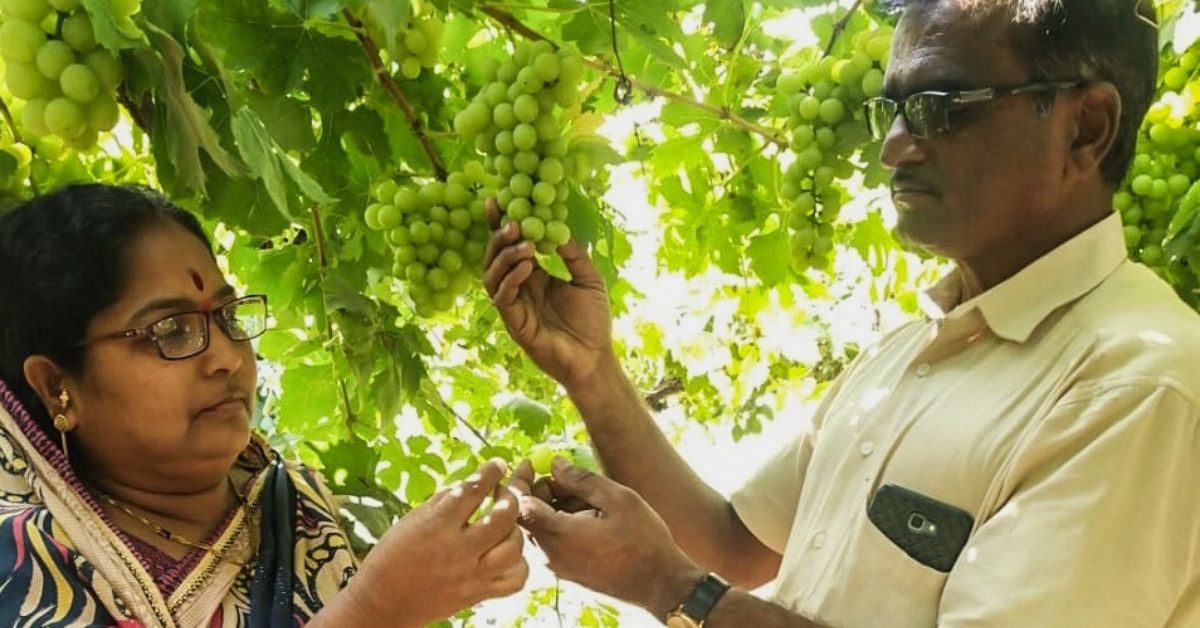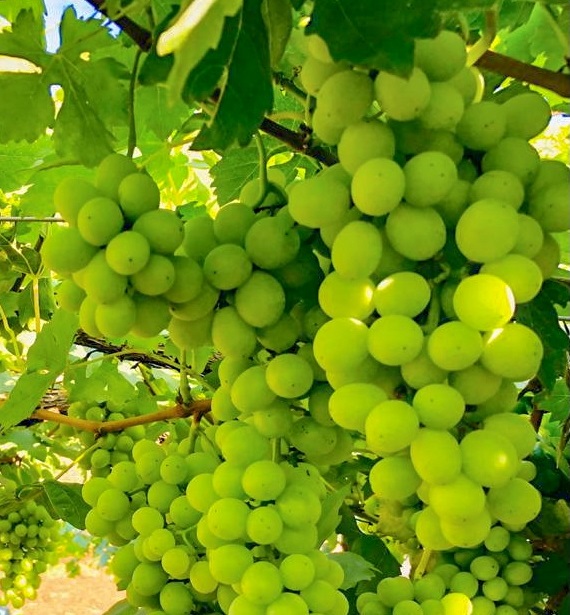After 20 Years of Work, 55-YO Farmer Develops Grape Variety With 40% Higher Yield
Having developed a nursery of the SS variety, Kshirsagar has sold saplings to more than 500 farmers. He believes that it is presently grown on 30,000 acres in Nashik district alone.

With The Positive Collective, The Better India’s COVID-19 coverage is available to regional language publications for free. Write to [email protected] for more details.
More than 20 varieties of grapes are cultivated in India. Maharashtra ranks first in terms of production, accounting for more than 81.22 per cent of total production in the country. However, only a dozen are commercially grown, grouped under the following four categories based on colour and seeds.
Thompson Seedless is the ruling grape variety, occupying 55 per cent of the area with its clones. Bangalore Blue occupies approximately 15 per cent of the total area, while Anab-e-Shahi and Dilkhush (15 per cent), Sharad Seedless (five per cent), Perlette (five per cent) and Gulabi and Bhokri together (five per cent).
For six decades, Thompson Seedless was used as a table variety and for making raisins and wine. But the emergence of this superior variety which ensures better yields leading to increased earnings, has challenged it.
Now, however, things are changing.
With every planting season, grape growers of Nashik are switching to a new variety called Sudhakar Seedless (SS) – developed by Sudhakar Kshirsagar, a local farmer-innovator.
The oval-shaped but mildly sweet ‘fresh white green’ SS variety was developed by 55-year-old Kshirsagar after nearly two decades of selective breeding. It has now become a favourite among grape-growers.

Growers say the broad leaf structure of SS allows free flow of air, besides ensuring easy passage for sprays, be it insecticides, pesticides, and plant growth regulators to the soil.
“This leads to the vine, and the fruit achieves dryness easily, ushering in the development of the root zone,” says Rushiraj Shantaram Dhikhale, 23. He is an agriculture graduate who planted the newly-developed variety in 2016 on his 1.5-acre plot in Pimpri Sayyad village in Nashik taluka.
Located in the east of the Western Ghats, the vineyards in Nashik are based in a semi-arid zone which is endowed with black soil. The average annual production of grapes here is 16 lakh tonnes during the season that lasts for six months, beginning November. Spread on close to two lakh acres, the average productivity of vineyards—the largest in the country—is around eight tonnes per acre, according to Maharashtra State Grape Growers Association (MSGGA), established in 1960.
Thanks to the involvement of agencies like NRC, Food Safety Standards Authority of India (FSSAI) and the MSGGA, grapes produced in Nashik since 2014 have been residue-free. This means that the grapes are 100 per cent safe to eat as the chemical residues are within the limits and that the fruit has been naturally ripened without any artificial interventions.
The berry is bigger, and the fruit’s low BRIX (sugar content) has enabled the SS to be well received in markets abroad, like the United Kingdom, Netherlands, and Russia. While traders in the domestic market offer a price between Rs 40-50 per kg, it attracts double the sum from exporters.
It was sometime in 1994 that Kshirsagar came across a lone plant in his vineyard in Shivade village in Niphad taluka; its leaves resembled that of a bitter gourd. Over the years, he developed 60 plants from it, cultivated them, and found the berry size unlike what he had seen so far.
Informs Kshirsagar, “The fruit is hard and extremely big, around 28 mm.” The Thompson variety is between 16-21 mm.
A commerce postgraduate, he was recently awarded an IPR (Intellectual Property Right) by the PPV&FRA (Protection of Plant Varieties & Farmers Right Authority) for developing a new variety of table grapes, which goes by his first name. He is among a handful of farmer-innovators who have received IPRs so far–the investigation process taking years, at times even a decade, before it is granted.
The PPV&FRA Act of 2001 provides for the establishment of an effective system for the protection of plant varieties, the rights of farmers and plant breeders, and encourages the development and cultivation of new varieties of plants. The scientists of the Pune-based National Research Centre for Grapes (NRC), attached to the Indian Council of Agricultural Research (ICAR) have validated Kshirsagar’s innovation.
Having developed a nursery of the SS variety, Kshirsagar has sold saplings to more than 500 farmers. He believes that it is presently grown on 30,000 acres in Nashik district alone.
A bunch of four sticks of SS cuttings is modestly priced at Rs 10. “I have a huge demand for saplings, which I am unable to meet,” he informs.
Forty-five km from Nashik town is Sonawadi village, which has a population of 600. Here, Baburao Kisan Sanap, 48, planted SS grafts on six acres in 2014, while growing sugarcane on his other 25 acres.
“Each year, I harvest between 150-200 quintals of grapes per acre, most of which are bought by exporters,” informs Sanap. “With each year, I have been reducing the acreage under Thompson variety.”

The acreage under SS is witnessing an upward trend across the grape-growing talukas of Nashik, though official confirmation on the total acreage dedicated to the variety is still awaited.
As its high yield and export potential become common knowledge, farmers in the State’s other grape-growing areas, like Jalna, Baramati, Solapur, Pune, and Ahmednagar, vie to adopt it. The shortcomings of Thompson, namely low demand in the export market, developing cracks in the rains, and its limitations while transporting, also add to its reducing popularity.
Says Adgaon resident Babasaheb Pundalik Shinde, 35, “SS is resilient to rain and drought, is less expensive to raise a plantation, and needs less irrigation, while its yield is 40 per cent higher.”
On Kshirsagar’s suggestion, Satana taluka’s Prakash Jibhu Deore, 63, planted SS on five acres in 2015. Two years later, he sold 17 tonnes of the fruit to exporters. He says, “The inputs required for this variety are much lower compared to the traditionally grown variety, and that’s the reason more farmers are opting for SS.”
Kshirsagar’s innovative variety is yet to receive certification from APEDA (Agricultural and Processed Food Products Exports Development Authority), Ministry of Commerce & Industry. Interestingly SS is being exported under the nomenclature of being Thompson Seedless as the granting of IPR for the latter is in process.
Also Read: Farmer Develops New Custard Apple That Doubles Yield, Has Fewer Seeds & More Pulp
He concludes, “APEDA, I am given to understand, is pursuing the issue of royalty with PPV&FRA. Once the matter is sorted, exporters will have to refer to it as Sudhakar Seedless, and pay the royalties for my innovation.”
Presently, farmers register annually to get a certificate and export their produce. Sudhakar Seedless, a table grape variety, has the potential to bring about revolutionary changes in the grape industry by increasing international trade and generating higher export earnings for the country.
(Edited by Shruti Singhal)
Like this story? Or have something to share?
Write to us: [email protected]
Connect with us on Facebook and Twitter.
If you found our stories insightful, informative, or even just enjoyable, we invite you to consider making a voluntary payment to support the work we do at The Better India. Your contribution helps us continue producing quality content that educates, inspires, and drives positive change.
Choose one of the payment options below for your contribution-
By paying for the stories you value, you directly contribute to sustaining our efforts focused on making a difference in the world. Together, let’s ensure that impactful stories continue to be told and shared, enriching lives and communities alike.
Thank you for your support. Here are some frequently asked questions you might find helpful to know why you are contributing?


This story made me
- 97
- 121
- 89
- 167











